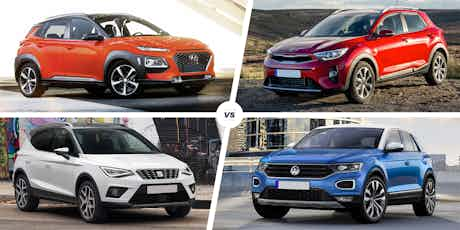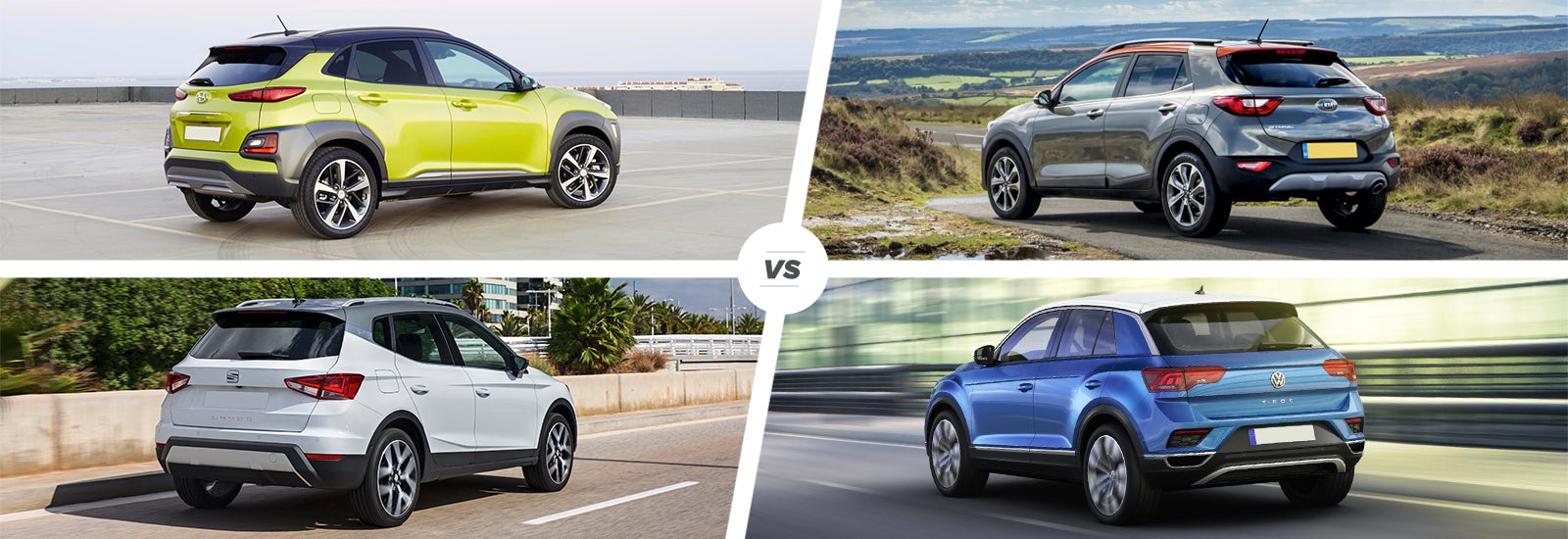Hyundai Kona vs Kia Stonic vs SEAT Arona vs VW T-Roc – which is the best small SUV?
November 03, 2017 by carwow staff

The small SUV market is growing bigger and bigger as more manufacturers are trying to squeeze into it. These four – the Hyundai Kona, Kia Stonic, SEAT Arona and VW T-Roc – are the newest, with two offering value for money and two offering a slightly more premium feel. So how do they all compare?

Prices
The entry-level Hyundai Kona (top left in all our galleries) is the least expensive car here, undercutting the equivalent Kia Stonic (top right) and SEAT Arona (bottom left) by £100 and £360 respectively. The Kona comes with air conditioning, Bluetooth, DAB radio, cruise control and electric windows as standard, but the standard infotainment screen is tiny and looks horribly dated. For £17,495, SE spec nabs fog lights, a much more modern seven-inch infotainment screen, Apple CarPlay and Android Auto connectivity, lumbar support and a reversing camera. You can spend up to £24,995 on a Premium GT spec, but we’d forgo it for either of the other ‘Premium’ trims that offer most of the goodies while costing noticeably less.
So far there are currently just two Stonic trims to choose from – the entry-level, £16,295 ‘2’ and the £19,695 First Edition. With Apple and Android connectivity, automatic headlights, rear parking sensors and air con as standard, ‘2’ is well-equipped for the price. Meanwhile, the higher spec adds satellite navigation, keyless entry, heated front seats, automatic braking, high beam assist and start/stop.
Unlike the Stonic, you’ll have to get a mid-spec Arona if you’re after Apple CarPlay and Android Auto, while only top-spec trims have sat-nav. That said, it’s slightly better for safety kit because all models get automatic emergency braking as standard, which will automatically stop you from low speeds the system detects an imminent collision.
You’ll have to dig deeper if you want a VW T-Roc (bottom right) – an entry-level SE model will set you back £20,425. Although seeing as even this entry-level model get 17-inch alloys, automatic emergency braking, front and rear parking sensors, start/stop, a large touchscreen and adaptive cruise control, it’s fairly good value for money. Design trim adds cosmetic upgrades and SEL offers 18-inch wheels, sat-nav and VW’s brilliant Active Info Display screen that replaces analogue dials.

Styling
It’s safe to say that the Kona is one of the most striking small SUVs on sale, with an aggressive front end featuring split-level lights like you get on a Nissan Juke or Citroen C3 Aircross. The black plastic cladding makes it look more like a larger SUV, although it can look a bit of a jumble from some angles. Compared to the Hyundai, the Stonic looks slightly conservative, but it still looks smart and rugged.
In fact, if you squint it looks pretty similar to the VW T-Roc, especially in a monochrome colour and viewed from the side. Both the Kona and Stonic need bright colours to look their best, and the VW looks smart in any colour, but spec a contrasting roof for the best effect if you’re shopping for an eye-catching T-Roc. But perhaps the sharpest-looking car in this test is the SEAT, with sharp lines and a sportier look than the others. It’s taller than the Ibiza on which it’s based, but is still desirable and sleek.

Interior
There’s a bit of a mismatch between the Kona’s exterior and interior – that’s because the innards are a bit boring. There are coloured inserts, but otherwise it’s not very interesting and some of the plastics and fittings feel a bit flimsy. On the plus side, all the controls are easy to use, there’s a lot of steering-wheel and seat adjustment and there’s just enough room for tall people to get comfy in the back.
Like the Kona, the Stonic’s cabin is easy to use but feels dreary and lifeless. The optional leather seats don’t hold you in place if you drive like a loon and they go without electric adjustment, the touchscreen is hard to use when moving and taller passengers will find it a bit of a squeeze in the rear.
At least it gets an infotainment system as standard, though – entry-level Aronas go without a coloured screen, which might make you question what decade we’re in. Opt for the infotainment and the interior looks smart and rugged, especially with coloured inserts, and there’s plenty of space for tall people and child seats.
The T-Roc has the best interior here and it’s taken mostly from the latest Polo. Colourful trim pieces really lift the interior and a 6.5-inch touchscreen is standard-fit. It’s not too bad in the back for leg and headroom, either.

Practicality
The Kona’s interior scores some points back when it comes to practicality. It hast a big glovebox, lots of cubbies to hide things out of view, a sunglasses holder, an adjustable boot floor and seats that almost fold flat. In fact, only the size of the boot lets it down, as 334 litres (or 361 if you go for the entry-level ‘S’ without a spare wheel) and 1,116 litres seats down isn’t really competitive in this market.
It’s swings and roundabouts with the Stonic, because the glovebox is smaller than the Kona’s but the door bins are large enough to hold both a 1.5-litre bottle and a 0.5-litre bottle at the same time. The boot floor is adjustable and usefully flat, and there are lots of tethering points, but 352 litres/ 1,155 litres of boot space isn’t as much as some rivals. The Arona, for example, offers a 400-litre boot with the seats up, but offers a smaller fuel tank than any of its rivals in this comparison.
According to VW, the T-Roc offers 445-litres of boot space with the seats up and 1,290 litres with the seats folded down.

Engines and driving
For the time being, there are only two engine options for the Kona. On the top-spec Premium GT model there’s a 177hp 1.6-litre petrol with four-wheel drive and comfy independent rear suspension, but choose a model from the rest of the range and you’re limited to a 1.0-litre three-cylinder turbo petrol unit delivering 120hp and a 0-62 time of 12 seconds. It’s perfectly adequate most of the time but struggles slightly up steep hills. Overall, the Hyundai is good to drive and there’s little road noise so long as you avoid the optional larger alloy wheels.
The Stonic offers a similar 1.0 turbocharged engine to the Kona, as well as a 1.4-litre non-turbo unit producing 99hp. Either the 1.0-litre engine or the torquey 1.6-litre diesel will suit most people’s needs best. The latter gets close to its claimed 67mpg fuel economy and pulls well. The Stonic is manual-only, front-wheel-drive-only and has light steering, while the suspension is good but the car rolls a lot through bends. In our Kia Stonic review we say it’s best at a relaxed pace, so perhaps isn’t one for the keener drivers.
The Arona and T-Roc also share some of their engines. Both are available with 115hp 1.0-litre petrols and 1.6-litre diesels, and a 150hp 1.5-litre turbo petrol with cylinder deactivation for better fuel economy. The Arona adds 94hp versions of both the lower-powered petrol and the diesel, while its VW cousin offers a 2.0-litre diesel with either 150hp or 190hp – the latter being auto-only and four-wheel-drive.
Strangely, the 115hp petrol is only available with an automatic gearbox in the SEAT and manual-only in the VW, and the 1.5 is only available on the Arona’s FR trim. It’s worth noting that the Arona has firmer suspension than the VW, but even the FR’s adaptive dampers can’t make the suspension as soft and comfy as the T-Roc’s.

Verdict
These four are all competent mini-SUVs and the best one depends entirely on your priorities. The Kona and Stonic cover the value end well, with the Kona being good to drive and sharply styled and the Stonic offering lots of equipment and load-lugging practicality. Both have long warranties too – the Hyundai has five years, while the Kia is covered for an impressive seven.
The Arona bridges the gap between its rivals and offers a great compromise between sportiness, practicality, style and value. That said, the entry-level model is best avoided because it just doesn’t feel special. If you’re after a premium-feeling small SUV, the T-Roc could suit your needs. It’s one of the biggest small SUVs with good practicality, strong engines and a stylish interior.
If you’re still undecided, see how much you can save on each model through carwow!
Cars Change? Carwow!
Looking for a new set of wheels? With Carwow you can sell your car quickly and for a fair price – as well as find great offers on your next one. Whether you’re looking to buy a car brand new, are after something used or you want to explore car leasing options, Carwow is your one stop shop for new car deals.















